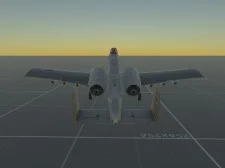Experience the Thrill of Realistic Flight Simulation Games
 Introduction to Flight Simulation Games
What is a Flight Simulation Game? A flight simulation game is a video game designed to simulate the experience of flying an aircraft. These games replicate the experience of controlling a plane with as much accuracy as possible, offering players a chance to experience the thrill of aviation without leaving the ground. From commercial jets to military fighters, flight simulators cover a wide range of aircraft and flight scenarios.
The Evolution of Flight Simulators Flight simulation games have come a long way since their inception. Early simulators were rudimentary, with basic graphics and limited controls. Today’s simulators offer photorealistic graphics, highly detailed cockpits, and sophisticated physics engines, making them a favorite among aviation enthusiasts and professional pilots alike.
Why Realistic Engines and Physics Matter
Importance of Engine Realism In flight simulation games, engine realism is crucial for an immersive experience. Realistic engine sounds and behavior provide a true-to-life flying experience, allowing players to experience the nuances of engine performance and management. Whether it’s the roar of a jet engine or the purr of a propeller, accurate engine simulation enhances the overall gaming experience.
Understanding Flight Physics Flight physics are the backbone of a realistic flight simulator. They dictate how an aircraft responds to various inputs and environmental factors, such as speed, altitude, and weather conditions. Realistic flight physics ensure that the simulator behaves like a real aircraft, providing players with an authentic flying experience.
Features of a High-Quality Flight Simulation Game
Realistic Engine Sounds and Behavior A top-notch flight simulator features realistic engine sounds and behavior. Engine sounds should accurately reflect different power settings and flight conditions, while engine behavior should mimic real-world performance characteristics. This attention to detail makes the simulation more immersive and believable.
Accurate Flight Physics and Controls High-quality flight simulators offer accurate flight physics and controls. This means that every action, from throttle adjustments to aerodynamic changes, should affect the aircraft in a realistic manner. Accurate controls ensure that players can replicate real-world flying techniques and maneuvers.
Immersive Graphics and Environments Immersive graphics and environments are essential for a compelling flight simulation experience. Detailed landscapes, realistic weather effects, and high-resolution textures contribute to the overall immersion, making players feel like they’re truly in the cockpit.
Getting Started with Your Flight Simulation Game
Essential Controls and Their Functions Before you take off, it’s important to familiarize yourself with the essential controls. From engine start-up to throttle management, understanding each control’s function will enhance your flying experience. Most simulators offer tutorials or control maps to help you get acquainted with the controls.
Pre-Flight Checklist A pre-flight checklist is crucial for a successful flight. Following a systematic checklist ensures that all necessary procedures are completed before takeoff, reducing the risk of errors and ensuring a smooth flight.
Detailed Pre-Flight Checklist
Turning On Aircraft Lights
How to Activate Aircraft Lights To ensure visibility and safety, start by turning on the aircraft lights. Press the Z key to activate the lights, which is crucial for both day and night flying. Proper lighting helps you be seen by other aircraft and ensures your cockpit is adequately illuminated.
Why Lights Are Crucial Aircraft lights are not just for visibility; they also signal your intentions to other pilots. Landing lights, navigation lights, and strobe lights all play a role in maintaining safety and communication in the air.
Lowering Flaps and Slats
The Role of Flaps and Slats Flaps and slats are critical for controlling lift and drag during takeoff and landing. Lowering these components increases lift at lower speeds, allowing for shorter takeoff runs and safer landings. Press the X key to adjust them as needed.
How to Adjust Them Properly Proper adjustment of flaps and slats involves understanding the specific needs of your aircraft and the current flight phase. Consult your aircraft’s manual or in-game guidance for precise settings.
Starting Up the Engines
Engine Start-Up Procedure Starting the engines involves a series of steps. Press the C key to initiate the start-up sequence. Ensure you follow the correct procedure for your aircraft, which usually includes checking fuel levels and battery status before engaging the engines.
Common Issues and Troubleshooting Engine start-up issues can occur due to various reasons, such as insufficient fuel or electrical problems. Refer to your aircraft’s troubleshooting guide for solutions if you encounter any problems during the start-up process.
Throttling Up the Engines
Proper Throttle Management Once the engines are running, it’s time to throttle up. Press the V key to increase engine power. Proper throttle management is essential for maintaining control and achieving the desired speed.
Effects of Throttle Adjustment Throttle adjustments affect the aircraft’s speed and performance. Increasing throttle boosts engine power and speed, while decreasing throttle reduces it. Mastering throttle control is crucial for smooth takeoffs and landings.
Releasing Parking Brakes
How to Release Parking Brakes Before moving, release the parking brakes by pressing the B key. This action allows the aircraft to roll forward and start its taxiing process.
Impact on Aircraft Movement Releasing the parking brakes enables the aircraft to move. Ensure you have completed all pre-flight checks before releasing the brakes to avoid sudden movements or accidents.
Rotating for Takeoff
Understanding Takeoff Speed Takeoff speed, typically around 150 knots for many aircraft, is crucial for a successful lift-off. Wait until your aircraft reaches this speed before initiating rotation.
How to Rotate Correctly To rotate, gently pull back on the control stick or yoke. Press the Down arrow key to initiate the rotation once the takeoff speed is achieved. Proper rotation ensures a smooth transition from ground to air.
Raising Landing Gear
When to Raise Landing Gear Once airborne and above 100 feet, raise the landing gear by pressing the M key. This reduces drag and improves aerodynamic efficiency.
How to Manage Landing Gear During Flight Proper management of landing gear is essential for safe flight operations. Ensure gear is raised during climb and extended for landing to ensure optimal performance and safety.
Advanced Flight Techniques
Managing Engine Power and Speed Advanced flight techniques involve precise management of engine power and speed. Adjust throttle settings based on flight conditions and desired performance.
Navigating Through Different Weather Conditions Navigating through various weather conditions requires skill and practice. Use instruments and adjust flight parameters to handle turbulence, wind, and visibility challenges.
Benefits of Playing Flight Simulation Games
Enhancing Cognitive Skills Flight simulators help enhance cognitive skills such as spatial awareness, problem-solving, and multitasking. Engaging in complex flight operations sharpens your mental acuity.
Providing an Educational Experience Flight simulation games offer an educational experience by teaching players about aviation principles and aircraft operations. They serve as a valuable learning tool for aspiring pilots and aviation enthusiasts.
Popular Flight Simulation Games
Microsoft Flight Simulator Microsoft Flight Simulator is renowned for its realism and immersive experience. With stunning graphics and accurate flight dynamics, it’s a top choice for serious flight enthusiasts.
X-Plane 12 X-Plane 12 offers a highly detailed and realistic flight experience with advanced weather systems and customizable aircraft. It’s known for its comprehensive simulation features.
DCS World DCS World is popular for its combat flight simulation and realistic military aircraft. It provides an intense and engaging experience for fans of military aviation.
Future Trends in Flight Simulation
Advances in VR and AR Technology Virtual Reality (VR) and Augmented Reality (AR) are set to revolutionize flight simulation. These technologies offer more immersive and interactive experiences.
Increasing Realism and Interactivity Future flight simulators will continue to enhance realism and interactivity, with improved graphics, more accurate physics, and better user interfaces. These advancements will further blur the line between simulation and reality.
Conclusion Flight simulation games offer a thrilling and educational experience with their realistic engines and physics. By following the pre-flight checklist and mastering advanced techniques, you can enjoy a truly immersive flying experience. Whether you’re a seasoned pilot or a newcomer, these simulators provide endless opportunities for exploration and learning.
FAQs
1. What are the key features to look for in a flight simulation game? Look for realistic engine sounds, accurate flight physics, and immersive graphics. These features enhance the overall experience and make the simulation more authentic.
2. How can I improve my flying skills using a flight simulator? Practice regularly and use the simulator’s training modules. Focus on mastering controls, navigation, and handling different weather conditions.
3. Are flight simulators suitable for beginners? Yes, many flight simulators offer beginner-friendly modes and tutorials. These resources help newcomers get acquainted with flying without feeling overwhelmed.
4. What are the best flight simulation games currently available? Some of the best options include Microsoft Flight Simulator, X-Plane 12, and DCS World. Each offers unique features and experiences for different types of flight enthusiasts.
5. How does VR enhance the flight simulation experience? VR provides a more immersive experience by simulating a cockpit environment around you. It enhances spatial awareness and makes the simulation feel more real.
Introduction to Flight Simulation Games
What is a Flight Simulation Game? A flight simulation game is a video game designed to simulate the experience of flying an aircraft. These games replicate the experience of controlling a plane with as much accuracy as possible, offering players a chance to experience the thrill of aviation without leaving the ground. From commercial jets to military fighters, flight simulators cover a wide range of aircraft and flight scenarios.
The Evolution of Flight Simulators Flight simulation games have come a long way since their inception. Early simulators were rudimentary, with basic graphics and limited controls. Today’s simulators offer photorealistic graphics, highly detailed cockpits, and sophisticated physics engines, making them a favorite among aviation enthusiasts and professional pilots alike.
Why Realistic Engines and Physics Matter
Importance of Engine Realism In flight simulation games, engine realism is crucial for an immersive experience. Realistic engine sounds and behavior provide a true-to-life flying experience, allowing players to experience the nuances of engine performance and management. Whether it’s the roar of a jet engine or the purr of a propeller, accurate engine simulation enhances the overall gaming experience.
Understanding Flight Physics Flight physics are the backbone of a realistic flight simulator. They dictate how an aircraft responds to various inputs and environmental factors, such as speed, altitude, and weather conditions. Realistic flight physics ensure that the simulator behaves like a real aircraft, providing players with an authentic flying experience.
Features of a High-Quality Flight Simulation Game
Realistic Engine Sounds and Behavior A top-notch flight simulator features realistic engine sounds and behavior. Engine sounds should accurately reflect different power settings and flight conditions, while engine behavior should mimic real-world performance characteristics. This attention to detail makes the simulation more immersive and believable.
Accurate Flight Physics and Controls High-quality flight simulators offer accurate flight physics and controls. This means that every action, from throttle adjustments to aerodynamic changes, should affect the aircraft in a realistic manner. Accurate controls ensure that players can replicate real-world flying techniques and maneuvers.
Immersive Graphics and Environments Immersive graphics and environments are essential for a compelling flight simulation experience. Detailed landscapes, realistic weather effects, and high-resolution textures contribute to the overall immersion, making players feel like they’re truly in the cockpit.
Getting Started with Your Flight Simulation Game
Essential Controls and Their Functions Before you take off, it’s important to familiarize yourself with the essential controls. From engine start-up to throttle management, understanding each control’s function will enhance your flying experience. Most simulators offer tutorials or control maps to help you get acquainted with the controls.
Pre-Flight Checklist A pre-flight checklist is crucial for a successful flight. Following a systematic checklist ensures that all necessary procedures are completed before takeoff, reducing the risk of errors and ensuring a smooth flight.
Detailed Pre-Flight Checklist
Turning On Aircraft Lights
How to Activate Aircraft Lights To ensure visibility and safety, start by turning on the aircraft lights. Press the Z key to activate the lights, which is crucial for both day and night flying. Proper lighting helps you be seen by other aircraft and ensures your cockpit is adequately illuminated.
Why Lights Are Crucial Aircraft lights are not just for visibility; they also signal your intentions to other pilots. Landing lights, navigation lights, and strobe lights all play a role in maintaining safety and communication in the air.
Lowering Flaps and Slats
The Role of Flaps and Slats Flaps and slats are critical for controlling lift and drag during takeoff and landing. Lowering these components increases lift at lower speeds, allowing for shorter takeoff runs and safer landings. Press the X key to adjust them as needed.
How to Adjust Them Properly Proper adjustment of flaps and slats involves understanding the specific needs of your aircraft and the current flight phase. Consult your aircraft’s manual or in-game guidance for precise settings.
Starting Up the Engines
Engine Start-Up Procedure Starting the engines involves a series of steps. Press the C key to initiate the start-up sequence. Ensure you follow the correct procedure for your aircraft, which usually includes checking fuel levels and battery status before engaging the engines.
Common Issues and Troubleshooting Engine start-up issues can occur due to various reasons, such as insufficient fuel or electrical problems. Refer to your aircraft’s troubleshooting guide for solutions if you encounter any problems during the start-up process.
Throttling Up the Engines
Proper Throttle Management Once the engines are running, it’s time to throttle up. Press the V key to increase engine power. Proper throttle management is essential for maintaining control and achieving the desired speed.
Effects of Throttle Adjustment Throttle adjustments affect the aircraft’s speed and performance. Increasing throttle boosts engine power and speed, while decreasing throttle reduces it. Mastering throttle control is crucial for smooth takeoffs and landings.
Releasing Parking Brakes
How to Release Parking Brakes Before moving, release the parking brakes by pressing the B key. This action allows the aircraft to roll forward and start its taxiing process.
Impact on Aircraft Movement Releasing the parking brakes enables the aircraft to move. Ensure you have completed all pre-flight checks before releasing the brakes to avoid sudden movements or accidents.
Rotating for Takeoff
Understanding Takeoff Speed Takeoff speed, typically around 150 knots for many aircraft, is crucial for a successful lift-off. Wait until your aircraft reaches this speed before initiating rotation.
How to Rotate Correctly To rotate, gently pull back on the control stick or yoke. Press the Down arrow key to initiate the rotation once the takeoff speed is achieved. Proper rotation ensures a smooth transition from ground to air.
Raising Landing Gear
When to Raise Landing Gear Once airborne and above 100 feet, raise the landing gear by pressing the M key. This reduces drag and improves aerodynamic efficiency.
How to Manage Landing Gear During Flight Proper management of landing gear is essential for safe flight operations. Ensure gear is raised during climb and extended for landing to ensure optimal performance and safety.
Advanced Flight Techniques
Managing Engine Power and Speed Advanced flight techniques involve precise management of engine power and speed. Adjust throttle settings based on flight conditions and desired performance.
Navigating Through Different Weather Conditions Navigating through various weather conditions requires skill and practice. Use instruments and adjust flight parameters to handle turbulence, wind, and visibility challenges.
Benefits of Playing Flight Simulation Games
Enhancing Cognitive Skills Flight simulators help enhance cognitive skills such as spatial awareness, problem-solving, and multitasking. Engaging in complex flight operations sharpens your mental acuity.
Providing an Educational Experience Flight simulation games offer an educational experience by teaching players about aviation principles and aircraft operations. They serve as a valuable learning tool for aspiring pilots and aviation enthusiasts.
Popular Flight Simulation Games
Microsoft Flight Simulator Microsoft Flight Simulator is renowned for its realism and immersive experience. With stunning graphics and accurate flight dynamics, it’s a top choice for serious flight enthusiasts.
X-Plane 12 X-Plane 12 offers a highly detailed and realistic flight experience with advanced weather systems and customizable aircraft. It’s known for its comprehensive simulation features.
DCS World DCS World is popular for its combat flight simulation and realistic military aircraft. It provides an intense and engaging experience for fans of military aviation.
Future Trends in Flight Simulation
Advances in VR and AR Technology Virtual Reality (VR) and Augmented Reality (AR) are set to revolutionize flight simulation. These technologies offer more immersive and interactive experiences.
Increasing Realism and Interactivity Future flight simulators will continue to enhance realism and interactivity, with improved graphics, more accurate physics, and better user interfaces. These advancements will further blur the line between simulation and reality.
Conclusion Flight simulation games offer a thrilling and educational experience with their realistic engines and physics. By following the pre-flight checklist and mastering advanced techniques, you can enjoy a truly immersive flying experience. Whether you’re a seasoned pilot or a newcomer, these simulators provide endless opportunities for exploration and learning.
FAQs
1. What are the key features to look for in a flight simulation game? Look for realistic engine sounds, accurate flight physics, and immersive graphics. These features enhance the overall experience and make the simulation more authentic.
2. How can I improve my flying skills using a flight simulator? Practice regularly and use the simulator’s training modules. Focus on mastering controls, navigation, and handling different weather conditions.
3. Are flight simulators suitable for beginners? Yes, many flight simulators offer beginner-friendly modes and tutorials. These resources help newcomers get acquainted with flying without feeling overwhelmed.
4. What are the best flight simulation games currently available? Some of the best options include Microsoft Flight Simulator, X-Plane 12, and DCS World. Each offers unique features and experiences for different types of flight enthusiasts.
5. How does VR enhance the flight simulation experience? VR provides a more immersive experience by simulating a cockpit environment around you. It enhances spatial awareness and makes the simulation feel more real.
Categories and tags of the game : 3d












